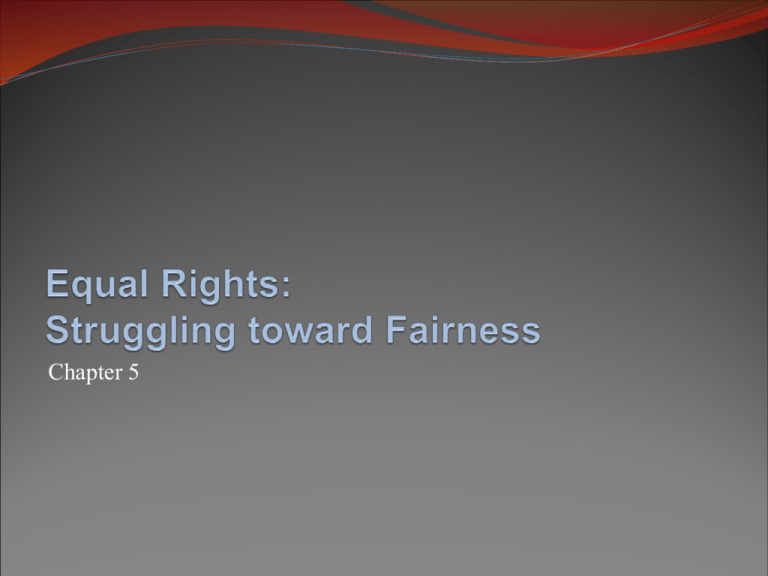
Chapter 5
Equality through Law
The Fourteenth Amendment: equal protection
Equal-protection clause forbids states from denying equal
protection
Segregation in the schools
Brown v. Board of Education of Topeka—banned forced
segregation in schools
Little change to segregation 15 years later
Supreme Court encouraged busing as solution to
segregation; highly controversial, mixed results
© 2015, McGraw-Hill Education. All Rights Reserved.
2
Equality through Law
Judicial tests of equal protection
Strict-scrutiny test
Suspect category—assumed unconstitutional in the absence of an
overwhelming justification
Applies to race, ethnicity, etc.
Intermediate scrutiny
Almost suspect —assumed unconstitutional unless the law serves
a clearly compelling and justified purpose; applies to gender
Reasonable-basis test
Not suspect category—assumed constitutional unless no sound
rationale for the law can be provided; applies to age, income, etc.
© 2015, McGraw-Hill Education. All Rights Reserved.
3
© 2015, McGraw-Hill Education. All Rights Reserved.
4
Equality through Law
The Civil Rights Act of 1964
Accommodations and jobs
Public accommodations cannot refuse to serve customers based
on race
Most employers cannot refuse to consider applicants based on
race
© 2015, McGraw-Hill Education. All Rights Reserved.
5
Equality through Law
The black civil rights movement
Impetus behind Civil Rights Act of 1964
Busing boycott led by Dr. Martin Luther King Jr.
March on Washington for Jobs and Freedom
Strong resistance to Civil Rights Act, but ultimately
successful
© 2015, McGraw-Hill Education. All Rights Reserved.
6
Equality through Law
The movement for women’s rights
Seneca Falls
Women acquire the right to vote in 1920 with Nineteenth
Amendment
The Equal Rights Amendment: passed Congress but failed
ratification by states
© 2015, McGraw-Hill Education. All Rights Reserved.
7
Equality through Law
Hispanic Americans and the farm workers’ strikes
Strikes in 1960s and 70s, largely for migrant workers’
rights; most success in California
Native Americans and their long-delayed rights
Granted citizenship in 1924
Protests in 1970s; greater control over own affairs
1968 Indian Bill of Rights
© 2015, McGraw-Hill Education. All Rights Reserved.
8
Equality through Law
Asian Americans and immigration
Long tradition of immigration restriction, ended 1965
Some legal victories in field of education
© 2015, McGraw-Hill Education. All Rights Reserved.
9
© 2015, McGraw-Hill Education. All Rights Reserved.
10
Equality through Law
The Voting Rights Act of 1965
Barring of whites-only primaries, 1940s
Twenty-fourth Amendment prohibited poll taxes, 1960s
Voting Rights Act of 1965 allowed federal agents to oversee
voter registration
States prevented from creating election districts that
deliberately dilute the minority vote, or to give it control
© 2014, McGraw-Hill Education. All Rights Reserved.
11
Equality through Law
The Civil Rights Act of 1968
Housing
Prohibition of redlining
© 2014, McGraw-Hill Education. All Rights Reserved.
12
What’s Your Opinion?
Should private discrimination be allowed?
Should private country clubs and organizations be allowed
to discriminate based on:
Religion, race, color, ethnic background?
Gender, age, income?
Physical characteristics, sexual preference, lifestyles?
© 2015, McGraw-Hill Education. All Rights Reserved.
13
Equality through Law
Affirmative action
Focus on “equality of result”
De facto discrimination
Social, economic, cultural biases—discrimination
De jure discrimination
Specific law—discrimination
© 2015, McGraw-Hill Education. All Rights Reserved.
14
Equality through Law
Affirmative action
Full and equal opportunities for all in education,
employment, etc.
Controversy over ends and means
Affirmative action in law
University of California Regents v. Bakke (1978)
Adarand v. Pena (1995)
© 2015, McGraw-Hill Education. All Rights Reserved.
15
What’s Your Opinion?
Which position on affirmative action programs comes
closer to your own point of view?
Keep them without rigid quotas?
Phase them out?
Don’t know or have an opinion?
© 2015, McGraw-Hill Education. All Rights Reserved.
16
The Continuing Struggle for Equality
African Americans
Aftermath of the civil rights movement
Continuing high disparity in income
Discrepancies in convictions and sentencing
High rate of dissolution of black families
Movement into political office
© 2014, McGraw-Hill Education. All Rights Reserved.
17
© 2015, McGraw-Hill Education. All Rights Reserved.
18
The Continuing Struggle for Equality
Women
Electoral and political successes
Job-related issues
Lack of job equality
Family leave
Gender pay equity
Sexual harassment
“Feminization of poverty”
© 2014, McGraw-Hill Education. All Rights Reserved.
19
© 2015, McGraw-Hill Education. All Rights Reserved.
20
The Continuing Struggle for Equality
Native Americans
Suits to regain land
Negative discrepancy in health, wealth, and education
Casinos; rising income but controversial
© 2015, McGraw-Hill Education. All Rights Reserved.
21
The Continuing Struggle for Equality
Hispanic Americans
Immigration and legal residence issues
Fastest growing minority; electoral success
© 2015, McGraw-Hill Education. All Rights Reserved.
22
The Continuing Struggle for Equality
Asian Americans
About 12 million Asian Americans
Emphasis on academic achievement in Asian American
communities
Upwardly mobile group
© 2015, McGraw-Hill Education. All Rights Reserved.
23
The Continuing Struggle for Equality
Gays and lesbians
Legal victories: Romer v. Evans, Lawrence v. Texas
Don’t Ask, Don’t Tell Repeal Act in 2010: gays and lesbians
can now serve openly in the armed services
© 2015, McGraw-Hill Education. All Rights Reserved.
24
The Continuing Struggle for Equality
Gays and lesbians
Legal setbacks: Boy Scouts exclusion policy upheld
Same-sex marriage legal in some states, but federal Defense
of Marriage Act (DOMA) allows states to deny marital
rights granted by other states
© 2015, McGraw-Hill Education. All Rights Reserved.
25
© 2015, McGraw-Hill Education. All Rights Reserved.
26
The Continuing Struggle for Equality
Other disadvantaged groups
Older Americans
Age Discrimination Act and Age Discrimination in Employment
Act
Disabled Americans
Americans with Disabilities Act
© 2015, McGraw-Hill Education. All Rights Reserved.
27
Discrimination:
Surface Differences, Deep Divisions
America’s high ideals often clash with its history
Frequent tendency or desire to avoid retelling the negative
aspects of American history
© 2015, McGraw-Hill Education. All Rights Reserved.
28






